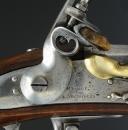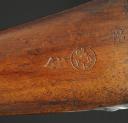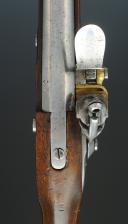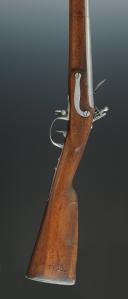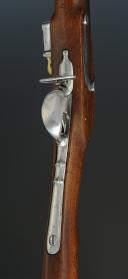
FUSIL À SILEX D'INFANTERIE PASSÉ À LA GARDE NATIONALE, MODÈLE 1777 CORRIGÉ AN XI, DE LA MANUFACTURE DE VERSAILLES, RESTAURATION.
Sold out
FLINTLOCK INFANTRY RIFLE PASSED ON TO THE NATIONAL GUARD, MODEL 1777 CORRECTED AN XI, FROM THE VERSAILLES MANUFACTURE, RESTORATION.
Barrel model 1777, with five short flats at the breech then round, length 103 cm, dated 1813, engraved breech tang "M 1777". All fittings in steel, secured by a steel spring. Walnut stock, cheek marked with the National Guard "PLD" at the cock (state property). Flintlock marked "Manufactured at Versailles", of the model 1777 corrected year XI.
Rifle length: 1.401 m. Iron ramrod.
Very good condition.
France.
Restoration.
NOTE:
END OF A LEGEND "PDL" THE STAMP ON NATIONAL GUARD WEAPONS
Numerous searches have not allowed me to find any citation that could confirm the reality of this motto "For the right." So what is it? What is the National Guard? The National Guard was created during the Revolution. It is a militia responsible for maintaining order and enforcing the law in troubled times. It consists of all citizens aged 20 to 60. They are listed and classified for service, either in reserve guard or active guard. Initially, the National Guards were mostly bourgeois because they were asked to equip themselves at their own expense, and to be in the cavalry, one needed to have a horse. This role for the bourgeois was a way to maintain a form of power, to stand out from the population of other citizens. The national guards are distributed in all municipalities. They act as the "Police" under the orders of a ranked officer, the mayor, and the prefect. During the Empire, the National Guard sometimes served as a reserve army. It was mobilized as needed for Napoleon's wars. After the dissolution of the National Guards by Charles X in 1827, it was reestablished by Louis Philippe in 1830. There would be a company in each municipality. Companies of infantry, artillery, cavalry, and even firefighters were formed. The National Guard was reactivated to quell disturbances and maintain peace throughout France after the July Revolution.
The marking of weapons with PDL in 1831
At the end of 1830, the minister wanted to bring order to the National Guards. He aimed to organize the troops and ordered the recovery and inventory of the weapons distributed earlier during the July Revolution. A document from the Lyon city archives dated August 10, 1830, attests to this.
In January 1831, a ministerial circular decided to mark the weapons that were distributed by the Ministry of War and thus belonged to the state. These would be stamped with a mark "PDL" representing "Property of the State," as evidenced by a document from January 20, 1831, from the prefecture to the Lyon archives.
This mark would be made using a punch that circulated from one village to another in each canton. The stamping would be done in the presence of the National Guards assembled armed by the mayors and commanders. The punch would remain the property of the canton capital. Thus, it would be possible to continue these markings in the future. A report would be drawn up, signed by the Mayor, and sent to the prefecture.
It should be noted that weapons belonging to the municipalities, purchased at their own expense or at the expense of the National Guards, were not affected by this marking measure.
The armament of the National Guards is very diverse. It includes rifles, sabers, cartridge boxes, and other military-type equipment and uniforms, often privately made, these equipment sometimes differing from the standard models. They were acquired by the National Guards themselves, as well as by the municipalities. There were also standard weapons provided to the municipalities as part of the Ministry of War's allocation. It was only this last category of equipment owned by the state that the ministry wanted to mark to attest to its ownership and prevent the dispersal of weapons. An excerpt from the January 1831 circular includes the printed notice attached to the punch intended for the municipalities. It outlines the method to be used for stamping rifles. The same circular mentions the creation, with the approval of the Minister of the Interior, of an armament manual for the National Guards.
In 1848, following the February Revolution and the advent of the Second Republic, a decree reactivated the National Guard in March. The first page of "Le Courrier de la Drôme et de l'Ardèche" dated October 29, 1848, No. 224, shows that the same measures as in 1831 (still in force) are taken with the inventory of the National Guards and their weapons. The "PDL" marking of state weapons is reaffirmed. Furthermore, it is noted that the conversion to percussion of National Guard weapons by private gunsmiths is prohibited. This is to prevent the proliferation of available calibers.
The "PLD" stamp
The mark on the wood created by striking a blackened metal imprint with the three letters "PDL" has long been interpreted as the motto "For The Right," which seems to have no basis. These documents show that it simply serves to remind of the "Property of the State." The rooster located at the top recalls a national symbol that was highlighted by Louis Philippe upon his arrival in power in 1831. This stamp can be found on the stocks of pistols and standard rifles used in the National Guard. These are mostly pistols like the troop models 1816 or 1822 and very often rifles like the model 1777 corrected year XI. The Ministry of War provided the National Guards with weapons from an outdated system, reserving the recent 1822 models for the military. Of course, later models such as the 1822 T and Tbis were also provided.
The PDL marking evolves
Furthermore, consulting military archive records has revealed other developments of this state identification mark.
PDL markings on edged weapons too
Observing swords or bayonets sometimes reveals this stamped mention.
[Source: http://www.lapistole.com/GDAestampillePDL.pdf]
Barrel model 1777, with five short flats at the breech then round, length 103 cm, dated 1813, engraved breech tang "M 1777". All fittings in steel, secured by a steel spring. Walnut stock, cheek marked with the National Guard "PLD" at the cock (state property). Flintlock marked "Manufactured at Versailles", of the model 1777 corrected year XI.
Rifle length: 1.401 m. Iron ramrod.
Very good condition.
France.
Restoration.
NOTE:
END OF A LEGEND "PDL" THE STAMP ON NATIONAL GUARD WEAPONS
Numerous searches have not allowed me to find any citation that could confirm the reality of this motto "For the right." So what is it? What is the National Guard? The National Guard was created during the Revolution. It is a militia responsible for maintaining order and enforcing the law in troubled times. It consists of all citizens aged 20 to 60. They are listed and classified for service, either in reserve guard or active guard. Initially, the National Guards were mostly bourgeois because they were asked to equip themselves at their own expense, and to be in the cavalry, one needed to have a horse. This role for the bourgeois was a way to maintain a form of power, to stand out from the population of other citizens. The national guards are distributed in all municipalities. They act as the "Police" under the orders of a ranked officer, the mayor, and the prefect. During the Empire, the National Guard sometimes served as a reserve army. It was mobilized as needed for Napoleon's wars. After the dissolution of the National Guards by Charles X in 1827, it was reestablished by Louis Philippe in 1830. There would be a company in each municipality. Companies of infantry, artillery, cavalry, and even firefighters were formed. The National Guard was reactivated to quell disturbances and maintain peace throughout France after the July Revolution.
The marking of weapons with PDL in 1831
At the end of 1830, the minister wanted to bring order to the National Guards. He aimed to organize the troops and ordered the recovery and inventory of the weapons distributed earlier during the July Revolution. A document from the Lyon city archives dated August 10, 1830, attests to this.
In January 1831, a ministerial circular decided to mark the weapons that were distributed by the Ministry of War and thus belonged to the state. These would be stamped with a mark "PDL" representing "Property of the State," as evidenced by a document from January 20, 1831, from the prefecture to the Lyon archives.
This mark would be made using a punch that circulated from one village to another in each canton. The stamping would be done in the presence of the National Guards assembled armed by the mayors and commanders. The punch would remain the property of the canton capital. Thus, it would be possible to continue these markings in the future. A report would be drawn up, signed by the Mayor, and sent to the prefecture.
It should be noted that weapons belonging to the municipalities, purchased at their own expense or at the expense of the National Guards, were not affected by this marking measure.
The armament of the National Guards is very diverse. It includes rifles, sabers, cartridge boxes, and other military-type equipment and uniforms, often privately made, these equipment sometimes differing from the standard models. They were acquired by the National Guards themselves, as well as by the municipalities. There were also standard weapons provided to the municipalities as part of the Ministry of War's allocation. It was only this last category of equipment owned by the state that the ministry wanted to mark to attest to its ownership and prevent the dispersal of weapons. An excerpt from the January 1831 circular includes the printed notice attached to the punch intended for the municipalities. It outlines the method to be used for stamping rifles. The same circular mentions the creation, with the approval of the Minister of the Interior, of an armament manual for the National Guards.
In 1848, following the February Revolution and the advent of the Second Republic, a decree reactivated the National Guard in March. The first page of "Le Courrier de la Drôme et de l'Ardèche" dated October 29, 1848, No. 224, shows that the same measures as in 1831 (still in force) are taken with the inventory of the National Guards and their weapons. The "PDL" marking of state weapons is reaffirmed. Furthermore, it is noted that the conversion to percussion of National Guard weapons by private gunsmiths is prohibited. This is to prevent the proliferation of available calibers.
The "PLD" stamp
The mark on the wood created by striking a blackened metal imprint with the three letters "PDL" has long been interpreted as the motto "For The Right," which seems to have no basis. These documents show that it simply serves to remind of the "Property of the State." The rooster located at the top recalls a national symbol that was highlighted by Louis Philippe upon his arrival in power in 1831. This stamp can be found on the stocks of pistols and standard rifles used in the National Guard. These are mostly pistols like the troop models 1816 or 1822 and very often rifles like the model 1777 corrected year XI. The Ministry of War provided the National Guards with weapons from an outdated system, reserving the recent 1822 models for the military. Of course, later models such as the 1822 T and Tbis were also provided.
The PDL marking evolves
Furthermore, consulting military archive records has revealed other developments of this state identification mark.
PDL markings on edged weapons too
Observing swords or bayonets sometimes reveals this stamped mention.
[Source: http://www.lapistole.com/GDAestampillePDL.pdf]
Reference :
19560
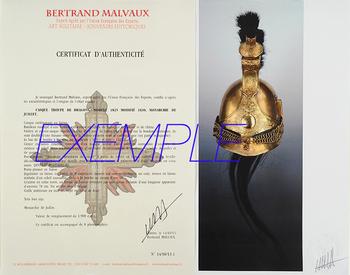
Next update Friday, november 7 at 13:30 PM
FOR ALL PURCHASES, PAYMENT IN MULTIPLE CHECKS POSSIBLE
bertrand.malvaux@wanadoo.fr 06 07 75 74 63
SHIPPING COSTS
Shipping costs are calculated only once per order for one or more items, all shipments are sent via registered mail, as this is the only way to have proof of dispatch and receipt.
For parcels whose value cannot be insured by the Post, shipments are entrusted to DHL or Fedex with real value insured, the service is of high quality but the cost is higher.
RETURN POLICY
Items can be returned within 8 days of receipt. They must be returned by registered mail at the sender's expense, in their original packaging, and in their original condition.
AUTHENTICITY
The selection of items offered on this site allows me to guarantee the authenticity of each piece described here, all items offered are guaranteed to be period and authentic, unless otherwise noted or restricted in the description.
An authenticity certificate of the item including the description published on the site, the period, the sale price, accompanied by one or more color photographs is automatically provided for any item priced over 130 euros. Below this price, each certificate is charged 5 euros.
Only items sold by me are subject to an authenticity certificate, I do not provide any expert reports for items sold by third parties (colleagues or collectors).
FOR ALL PURCHASES, PAYMENT IN MULTIPLE CHECKS POSSIBLE
bertrand.malvaux@wanadoo.fr 06 07 75 74 63
An authenticity certificate of the item including the description published on the site, the period, the sale price, accompanied by one or more color photographs is automatically provided for any item priced over 130 euros. Below this price, each certificate is charged 5 euros.
Only items sold by me are subject to an authenticity certificate, I do not provide any expert reports for items sold by third parties (colleagues or collectors).




